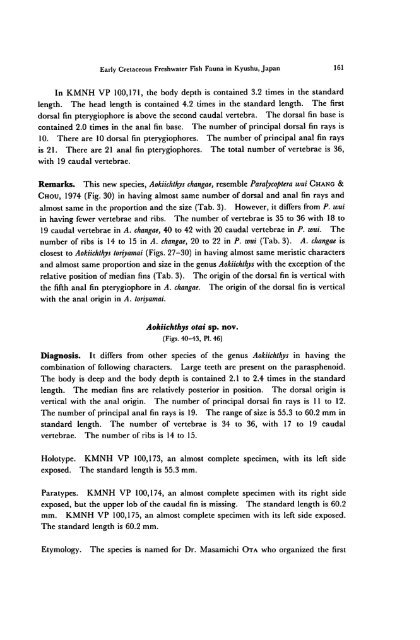Early Cretaceous Freshwater Fish Fauna in Kyushu, Japan
Early Cretaceous Freshwater Fish Fauna in Kyushu, Japan
Early Cretaceous Freshwater Fish Fauna in Kyushu, Japan
You also want an ePaper? Increase the reach of your titles
YUMPU automatically turns print PDFs into web optimized ePapers that Google loves.
<strong>Early</strong> <strong>Cretaceous</strong> <strong>Freshwater</strong> <strong>Fish</strong> <strong>Fauna</strong> <strong>in</strong> <strong>Kyushu</strong>, <strong>Japan</strong> 161<br />
In KMNH VP 100,171, the body depth is conta<strong>in</strong>ed 3.2 times <strong>in</strong> the standard<br />
length. The head length is conta<strong>in</strong>ed 4.2 times <strong>in</strong> the standard length. The first<br />
dorsal f<strong>in</strong> pterygiophore is above the second caudal vertebra. The dorsal f<strong>in</strong> base is<br />
conta<strong>in</strong>ed 2.0 times <strong>in</strong> the anal f<strong>in</strong> base. The number of pr<strong>in</strong>cipal dorsal f<strong>in</strong> rays is<br />
10. There are 10 dorsal f<strong>in</strong> pterygiophores. The number of pr<strong>in</strong>cipal anal f<strong>in</strong> rays<br />
is 21. There are 21 anal f<strong>in</strong> pterygiophores. The total number of vertebrae is 36,<br />
with 19 caudal vertebrae.<br />
Remarks. This new species, Aokiichthys changae, resemble Paralycoptera wui Chang &<br />
Chou, 1974 (Fig. 30) <strong>in</strong> hav<strong>in</strong>g almost same number of dorsal and anal f<strong>in</strong> rays and<br />
almost same <strong>in</strong> the proportion and the size (Tab. 3). However, it differs from P. wui<br />
<strong>in</strong> hav<strong>in</strong>g fewer vertebrae and ribs. The number of vertebrae is 35 to 36 with 18 to<br />
19 caudal vertebrae <strong>in</strong> A. changae, 40 to 42 with 20 caudal vertebrae <strong>in</strong> P. wui. The<br />
number of ribs is 14 to 15 <strong>in</strong> A. changae, 20 to 22 <strong>in</strong> P. wui (Tab. 3). A. changae is<br />
closest to Aokiichthys toriyamai (Figs. 27-30) <strong>in</strong> hav<strong>in</strong>g almost same meristic characters<br />
and almost same proportion and size <strong>in</strong> the genus Aokiichthys with the exception of the<br />
relative position of median f<strong>in</strong>s (Tab. 3). The orig<strong>in</strong> of the dorsal f<strong>in</strong> is vertical with<br />
the fifth anal f<strong>in</strong> pterygiophore <strong>in</strong> A. changae. The orig<strong>in</strong> of the dorsal f<strong>in</strong> is vertical<br />
with the anal orig<strong>in</strong> <strong>in</strong> A. toriyamai.<br />
Aokiichthys otai sp. nov.<br />
(Figs. 40-43, PI. 46)<br />
Diagnosis. It differs from other species of the genus Aokiichthys <strong>in</strong> hav<strong>in</strong>g the<br />
comb<strong>in</strong>ation of follow<strong>in</strong>g characters. Large teeth are present on the parasphenoid.<br />
The body is deep and the body depth is conta<strong>in</strong>ed 2.1 to 2.4 times <strong>in</strong> the standard<br />
length. The median f<strong>in</strong>s are relatively posterior <strong>in</strong> position. The dorsal orig<strong>in</strong> is<br />
vertical with the anal orig<strong>in</strong>. The number of pr<strong>in</strong>cipal dorsal f<strong>in</strong> rays is 11 to 12.<br />
The number of pr<strong>in</strong>cipal anal f<strong>in</strong> rays is 19. The range of size is 55.3 to 60.2 mm <strong>in</strong><br />
standard length. The number of vertebrae is 34 to 36, with 17 to 19 caudal<br />
vertebrae. The number of ribs is 14 to 15.<br />
Holotype.<br />
exposed.<br />
KMNH VP 100,173, an almost complete specimen, with its left side<br />
The standard length is 55.3 mm.<br />
Paratypes. KMNH VP 100,174, an almost complete specimen with its right side<br />
exposed, but the upper lob of the caudal f<strong>in</strong> is miss<strong>in</strong>g. The standard length is 60.2<br />
mm. KMNH VP 100,175, an almost complete specimen with its left side exposed.<br />
The standard length is 60.2 mm.<br />
Etymology.<br />
The species is named for Dr. Masamichi Ota who organized the first

















